Genetic Anticipation Is Associated with Telomere Shortening in Hereditary Breast Cancer
There is increasing evidence suggesting that short telomeres and subsequent genomic instability contribute to malignant transformation. Telomere shortening has been described as a mechanism to explain genetic anticipation in dyskeratosis congenita and Li-Fraumeni syndrome. Since genetic anticipation has been observed in familial breast cancer, we aimed to study telomere length in familial breast cancer patients and hypothesized that genetic defects causing this disease would affect telomere maintenance resulting in shortened telomeres. Here, we first investigated age anticipation in mother-daughter pairs with breast cancer in 623 breast cancer families, classified as BRCA1, BRCA2, and BRCAX. Moreover, we analyzed telomere length in DNA from peripheral blood leukocytes by quantitative PCR in a set of 198 hereditary breast cancer patients, and compared them with 267 control samples and 71 sporadic breast cancer patients. Changes in telomere length in mother-daughter pairs from breast cancer families and controls were also evaluated to address differences through generations. We demonstrated that short telomeres characterize hereditary but not sporadic breast cancer. We have defined a group of BRCAX families with short telomeres, suggesting that telomere maintenance genes might be susceptibility genes for breast cancer. Significantly, we described that progressive telomere shortening is associated with earlier onset of breast cancer in successive generations of affected families. Our results provide evidence that telomere shortening is associated with earlier age of cancer onset in successive generations, suggesting that it might be a mechanism of genetic anticipation in hereditary breast cancer.
Published in the journal:
. PLoS Genet 7(7): e32767. doi:10.1371/journal.pgen.1002182
Category:
Research Article
doi:
https://doi.org/10.1371/journal.pgen.1002182
Summary
There is increasing evidence suggesting that short telomeres and subsequent genomic instability contribute to malignant transformation. Telomere shortening has been described as a mechanism to explain genetic anticipation in dyskeratosis congenita and Li-Fraumeni syndrome. Since genetic anticipation has been observed in familial breast cancer, we aimed to study telomere length in familial breast cancer patients and hypothesized that genetic defects causing this disease would affect telomere maintenance resulting in shortened telomeres. Here, we first investigated age anticipation in mother-daughter pairs with breast cancer in 623 breast cancer families, classified as BRCA1, BRCA2, and BRCAX. Moreover, we analyzed telomere length in DNA from peripheral blood leukocytes by quantitative PCR in a set of 198 hereditary breast cancer patients, and compared them with 267 control samples and 71 sporadic breast cancer patients. Changes in telomere length in mother-daughter pairs from breast cancer families and controls were also evaluated to address differences through generations. We demonstrated that short telomeres characterize hereditary but not sporadic breast cancer. We have defined a group of BRCAX families with short telomeres, suggesting that telomere maintenance genes might be susceptibility genes for breast cancer. Significantly, we described that progressive telomere shortening is associated with earlier onset of breast cancer in successive generations of affected families. Our results provide evidence that telomere shortening is associated with earlier age of cancer onset in successive generations, suggesting that it might be a mechanism of genetic anticipation in hereditary breast cancer.
Introduction
Genetic anticipation is the observation of progressively earlier age of onset or an increase of severity of clinical features of a genetic disorder as it is passed on to the next generation. The molecular mechanisms underlying anticipation are largely unknown, but it has been typically associated to trinucleotide repeat expansions in several genetic diseases [1], [2]. In cancer, genetic anticipation has previously been described in several hereditary cancer syndromes, such as hereditary non-polyposis colorectal cancer (HNPCC) [3], [4], familial leukemia [5], Li-Fraumeni Syndrome[6]–[8] and also in familial breast and ovarian cancer [9]–[11].
Telomere shortening has been more recently described as another mechanism of anticipation, being associated with early onset and severity of disease in genetic disorders, such as dyskeratosis congenita [12], [13], a disease characterized by cutaneous abnormalities, bone marrow failure and an increased predisposition to cancer, and in the Li-Fraumeni Syndrome [7], [8]. Families with dyskeratosis congenita have mutations in genes in the telomerase or shelterin complex, causing reduced telomerase activity. Telomeres are nucleoprotein structures that protect the end of chromosomes. Telomeres shorten with each cell cycle and there is increasing evidence suggesting that short telomeres and subsequent genomic instability contribute to malignant transformation.
In this way, data from several case-control studies have indicated that individuals with relatively short mean telomere lengths might have an increased risk for developing cancer [14], [15]. In particular, telomere length and risk of breast cancer have been evaluated in different studies, although disparities among the results did not allow final conclusions [16]–[19].
Inherited predisposition to breast cancer accounts for approximately 5% of all cases and is characterized by an autosomal dominant pattern of inheritance, young age of onset and bilateral breast cancer. Familial breast and ovarian cancer (FBOC) is associated with inherited mutations mainly in two genes, BRCA1 and BRCA2. Women who have inherited mutations in either one of these genes have a high risk of developing breast cancer, ovarian cancer, and several other types of cancer during their lifetimes. However, a large proportion of familial breast cancer is not caused by mutations in BRCA1 or BRCA2. These non-BRCA1/2 breast cancer families (referred to as BRCAX families) comprise a histopathologically heterogeneous group, further supporting their origin being from other genetic events [20].
Telomere length maintenance is a complex process controlled by a large number of different proteins, and in addition to telomere binding proteins, many other proteins commonly involved in DNA repair are also found at telomeric ends [21]. BRCA1 and BRCA2 genes are involved in repair of DNA double strand breaks. Inherited defects in these genes lead to chromosomal instability contributing to malignant cell transformation. Importantly, there is evidence that BRCA1 localized at telomeres and may regulate telomere length and stability [22]–[24]. In addition BRCA2 has been very recently described to be implicated in telomere replication [25].
Based on all these data we hypothesized that telomere shortening may be associated to age anticipation in hereditary breast cancer. In this study, we analyzed telomere length in DNA from peripheral blood leukocytes in familial breast cancer cases and evaluated generational changes in telomere length in mother-daughter pairs with the aim to investigate the role of telomere shortening and its potential implication as a mechanism of age anticipation in familial breast cancer.
Results
Anticipation in the age of breast cancer onset in familial breast cancer
The occurrence of age anticipation in mother-daughter pairs with breast cancer was analyzed in 623 FBOC families, classified as BRCA1 (40 families), BRCA2 (52 families), and BRCAX (531 families). The distributions of age at diagnosis for mother and daughters showed a consistent shift to earlier ages in daughters (Figure 1). Evidence for anticipation comparing the age of breast cancer diagnosis in daughters and respective mothers from these families was found after t-test in the three genetic groups. Breast cancer was diagnosed at an average of 6.8 years earlier in daughters in the BRCA1 families (p = 0.002) (Table 1). In the BRCA2 and BRCAX groups, a more significant earlier age of diagnosis in daughters was found, being 12.1 years in the BRCA2 (p = 2.9×10−7) and 12.3 years in the BRCAX families (p = 1.5×10−55). Therefore, significant differences were found in the age of onset between mothers and daughters in the three groups, showing the BRCA2 and BRCAX groups stronger apparent anticipation effect than BRCA1 group.


Telomere length of hereditary and sporadic breast cancer cases
In order to evaluate the hypothesis that telomere shortening may be associated with the earlier onset of the disease, we investigated the mean relative telomere length of blood leukocytes in index cases from FBOC families, either BRCA1 (48 cases), BRCA2 (45 cases), or BRCAX (105 cases), and compared with the relative telomere length of a normal population of healthy women covering an age range between 23 and 70 years (267 samples) (Figure 2). Interestingly, telomere lengths in affected individuals from BRCA1 and BRCA2 families were significantly shorter than those in the control population after adjustment for age using the line of best fit from controls (p<0.0001) (Figure 3). High risk BRCAX families showed a more heterogeneous distribution of telomere length, with cases of both short and long telomeres. Adjusting for age, this group also demonstrated significant differences to the controls (p = 0.031) (Figure 3). We also compared the mean telomere length in blood leukocytes from a group of 71 sporadic breast cancer patients. Importantly, age-adjusted telomere length distribution in these cases did not differ from controls (p = 0.133) (Figure 2 and Figure 3). Therefore, hereditary but not sporadic breast cancer seems to be characterized by short telomeres, primarily in BRCA1 and BRCA2 mutation carriers, but also in a subgroup of BRCAX.
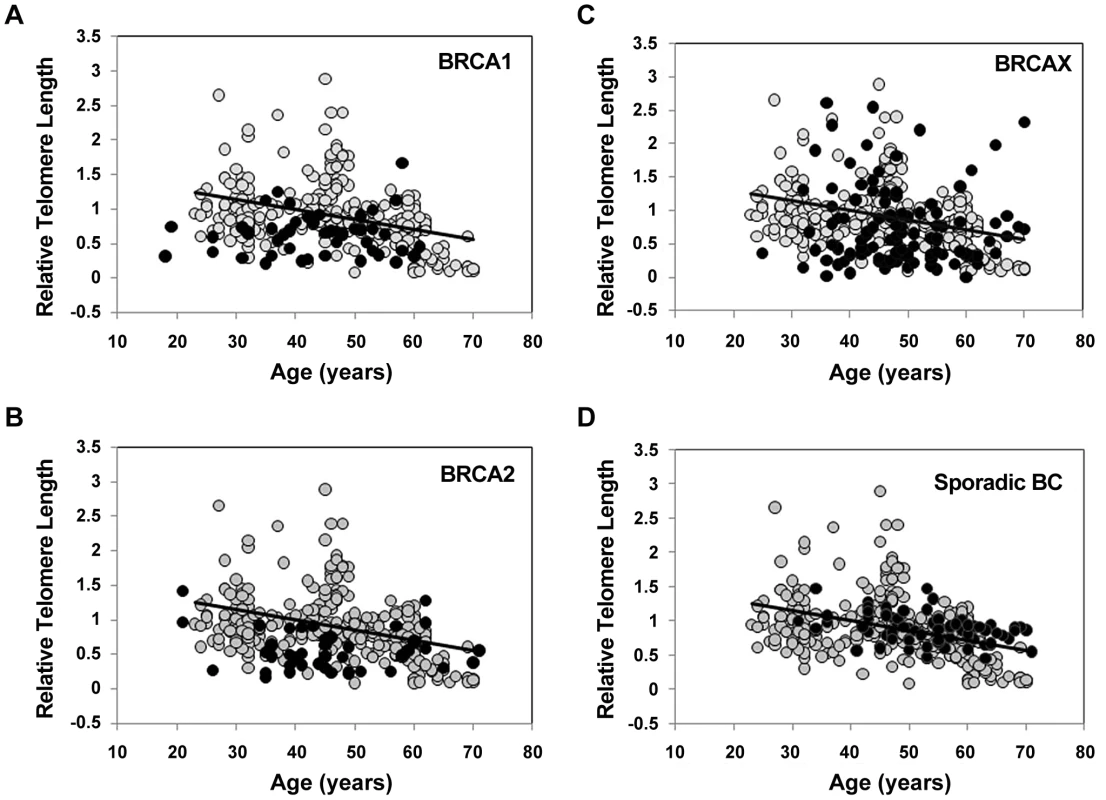
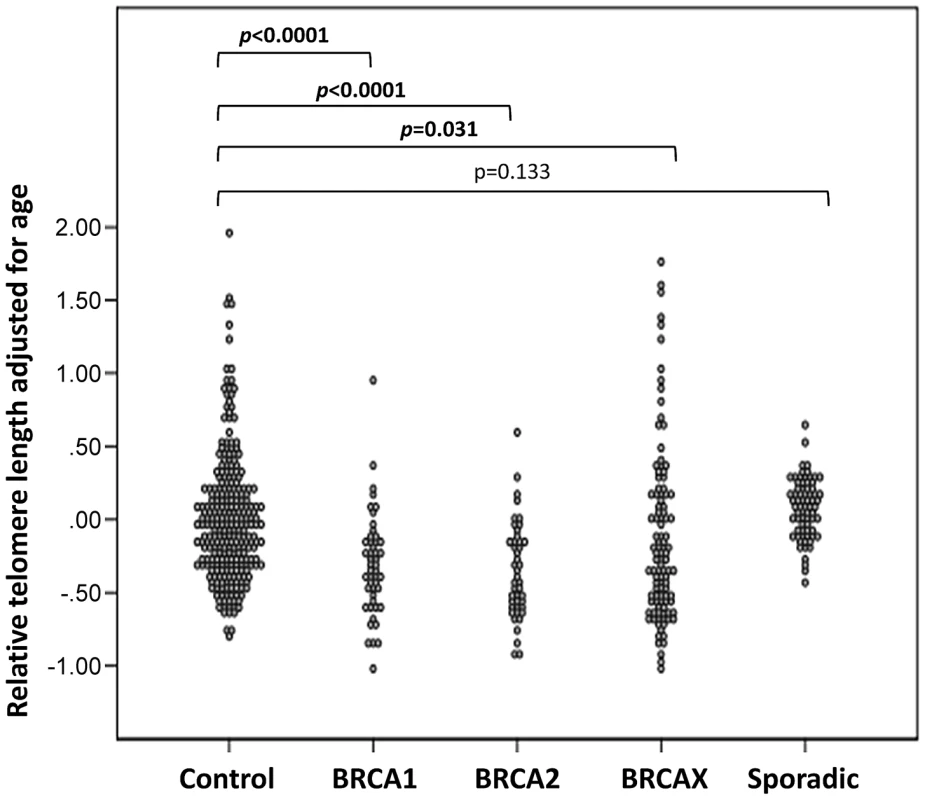
Telomere length in mutation carriers and non-carriers from BRCA1/2 families
Since BRCA1 or BRCA2 mutations were found associated with short telomeres, we further explored whether the altered function of these genes would be causing a reduction in telomere length or whether short telomeres were the consequence of other genetic or environmental factors present in these families. We analyzed telomere length of 19 affected women carrying BRCA1/2 mutations (8 BRCA1 and 11 BRCA2) and 22 sisters from the same families (8 BRCA1 and 14 BRCA2) who did not inherit the mutations (Figure 4). Affected BRCA1/2 mutation carriers showed not only significantly shorter telomeres than the unrelated normal controls (p<0.0001) but also versus the healthy sisters not carrying the mutation (p = 0.034). Telomeres of these healthy sisters do not significantly differ from the normal control population (p = 0.177) suggesting that short telomeres are not likely the result of a predisposing genetic background or environment, which was shared by mutation carrier and non-carrier sisters, but would rather be a consequence of the mutation in the BRCA1/2 genes. So, it seems that haploinsufficiency for BRCA1 or BRCA2 in heterozygous women contributes to progressive telomere shortening at a somatic and germline level, affecting the age of cancer onset in successive generations. Because in the BRCAX group the causing mutations are unknown, a similar study cannot be performed, but it is possible that at least a subgroup of BRCAX families characterized by shorter telomeres were associated to mutations in other genes with a role in telomere maintenance.
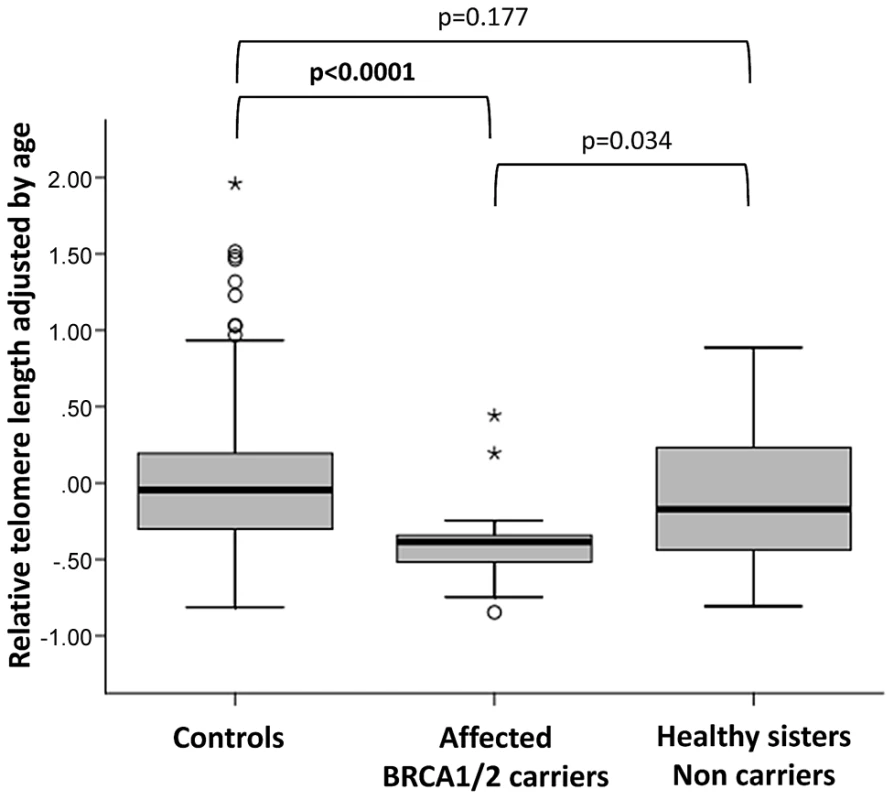
Stratification of BRCAX families by telomere length
To better characterize the subgroup of BRCAX families with short telomeres, we divided breast cancer cases into quartiles of telomere length, according to the telomere length distribution in control samples (Figure 5). A significant increase of the first quartile (shortest telomeres) representing 50–70% of the cases in the BRCA1, BRCA2, and BRCAX groups was observed (p = 0.003, p<0.0001, and p<0.0001, respectively). In contrast, the proportion of cases in the first quartile significantly decreased in the sporadic breast cancer group compared to the controls (10% of cases, p = 0.0026). These results suggested that familial breast cancer, BRCA1 and BRCA2, but also a subgroup of BRCAX, was characterized by short telomeres in peripheral blood cells. We further stratified BRCAX families based on the number of generations in which individuals with breast cancer appeared (Table 2). Thus, there were families in which the proband's generation was the first one with affected individuals, and families in which, in addition to the proband's generation, there were one or two additional generations with cancer. Interestingly, those BRCAX families with only one generation affected corresponded almost completely to the fourth quartile characterized by the longest telomeres (Table 2), suggesting that shortening of telomere length might be occurring in successive generations.
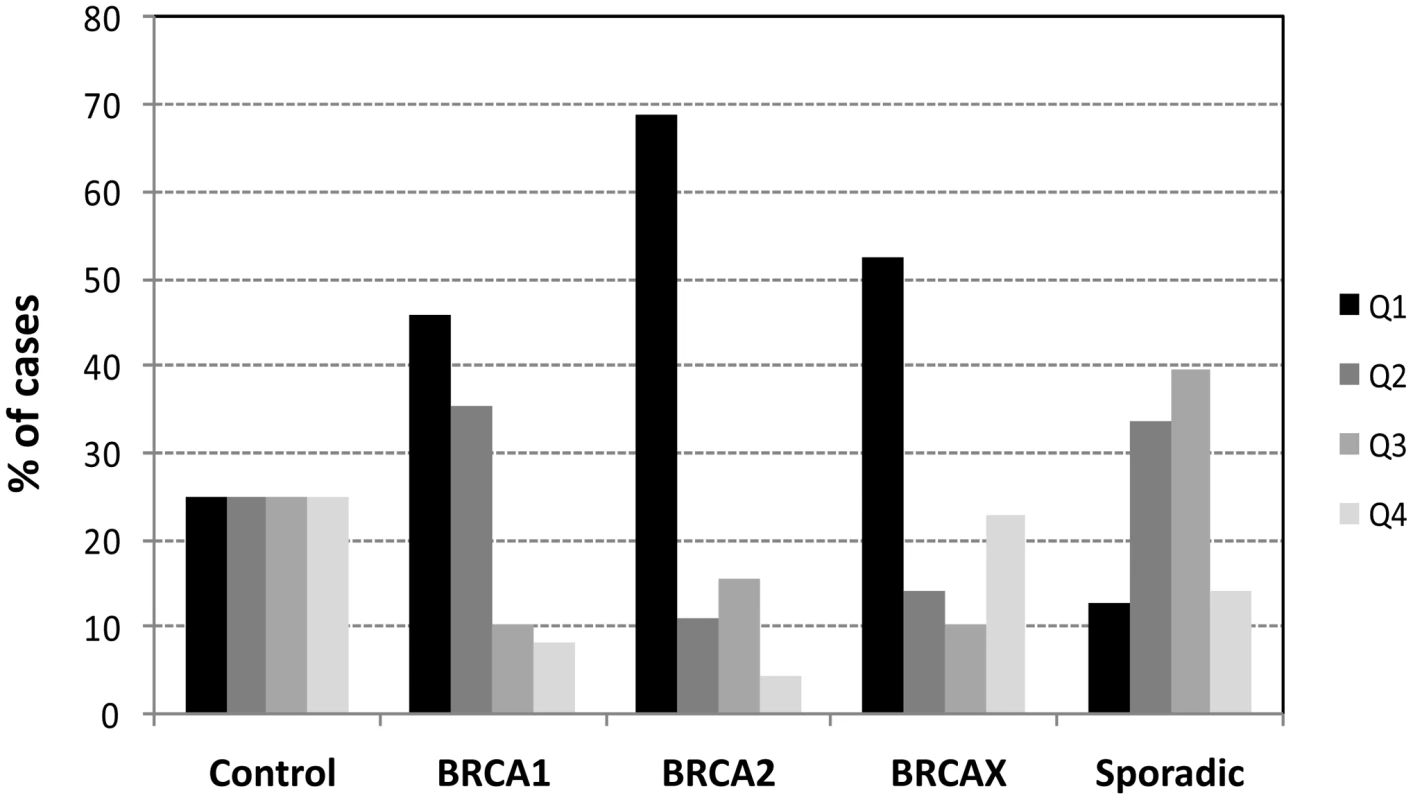

Changes in telomere length in mother-daughter pairs from breast cancer families
We next investigated the relation between telomere length and genetic anticipation in breast cancer. We measured changes in telomere length in 19 mother-daughter pairs from FBOC families (3 BRCA1, 1 BRCA2, and 15 BRCAX) who developed breast cancer (Figure 6) (Table 3) and compared them to 16 normal mother-daughter pairs. We additionally analyzed telomeres in 12 pairs of affected mothers from BRCA1/2 families and their respective daughters who were mutation carriers but did not develop cancer to date (Table 4). Telomere length was adjusted for age and we evaluated telomere differences between mothers and daughters in the three groups: both mothers and daughters affected, affected mothers and unaffected mutation-carrying daughters, and mother and daughter controls (Figure 7A). Interestingly, telomere length significantly decreased not only in affected daughters (p = 0.00018) but also in unaffected daughters who were carriers of BRCA1/2 mutations (p = 0.003), while the change between control mothers and daughters was not statistically significant (p = 0.341). This indicates that telomere shortening was associated in these mother-daughter transmissions to the inheritance of a genetic mutation rather than with the disease. Looking at the difference in telomere length of mother-daughter pairs (Figure 7B), significantly larger differences in pairs from affected families were found compared to controls (p = 0.003), with telomeres being shorter in daughters of breast cancer families compared with normal mother-daughter pairs. This decrease in telomere length in successive generations suggests that telomere length could explain age anticipation in familial breast cancer.
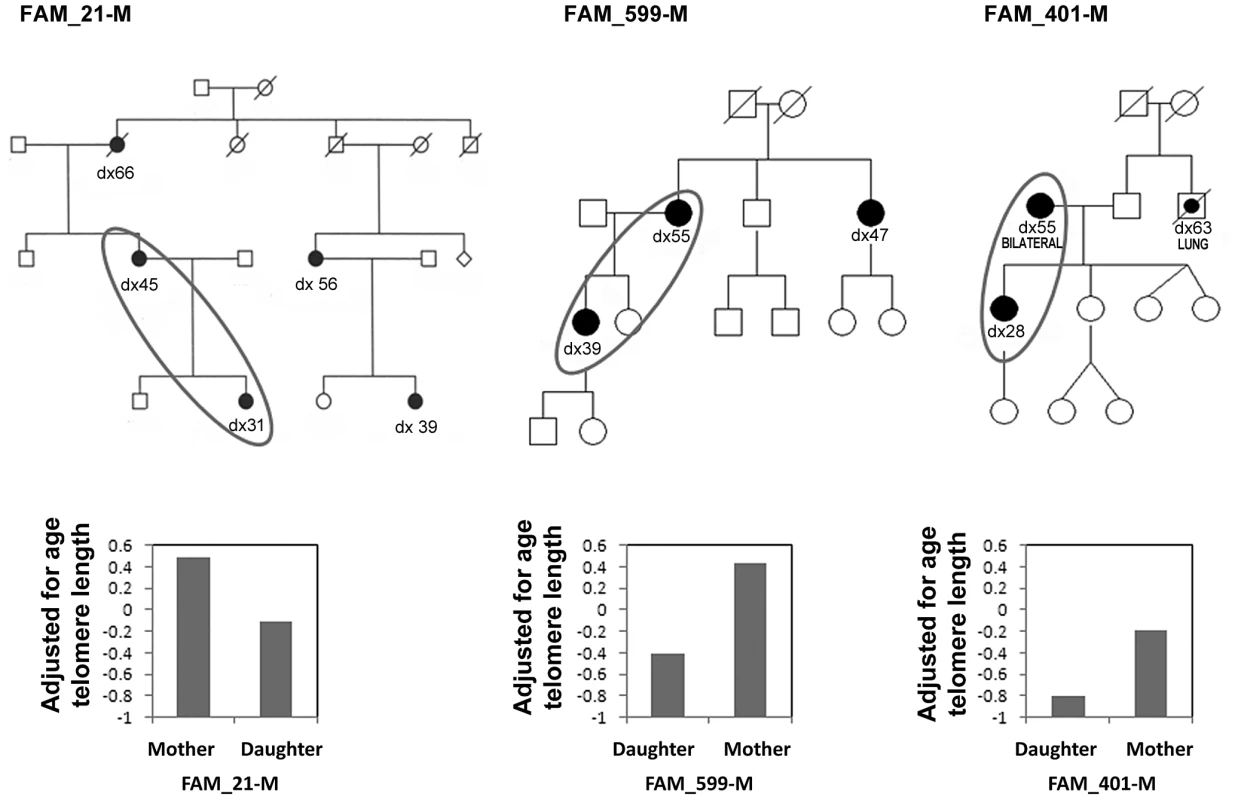
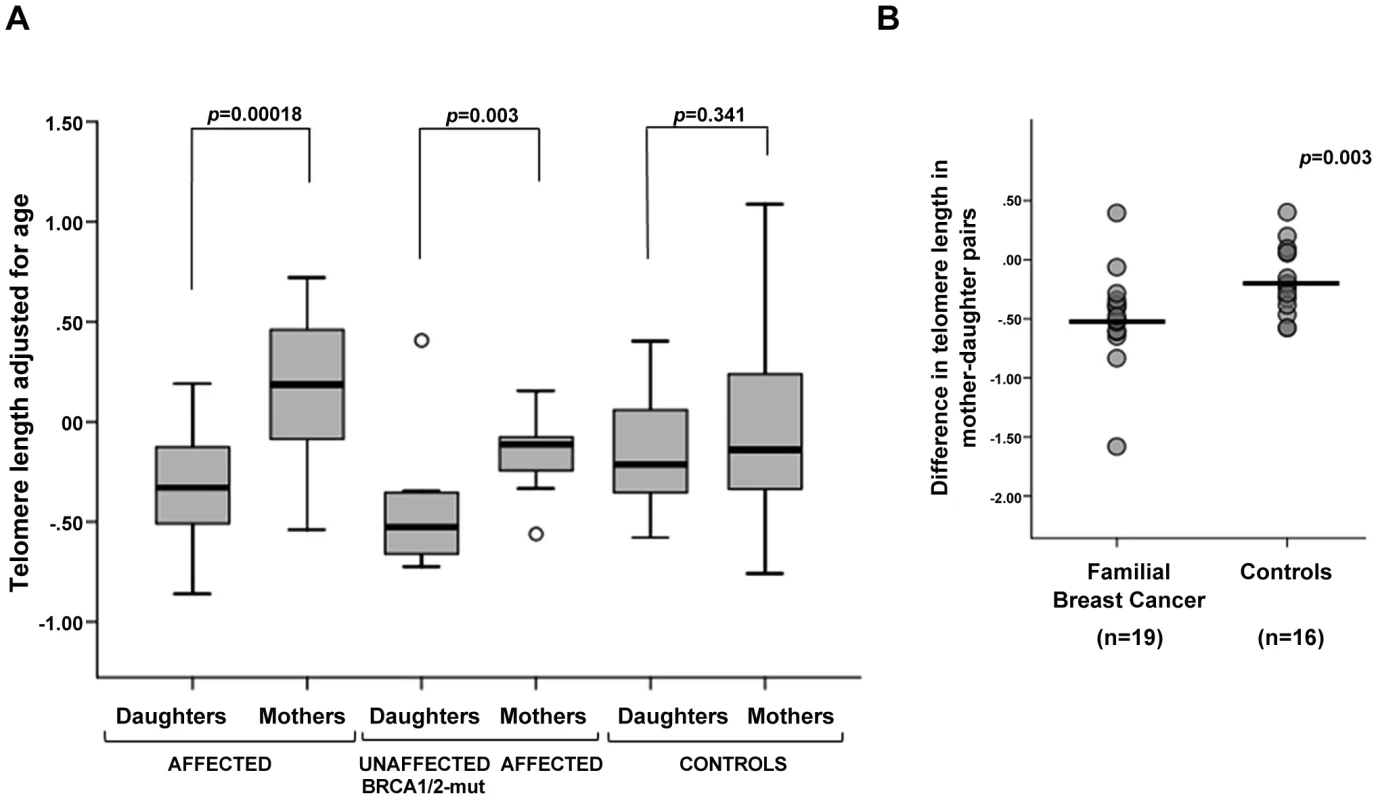
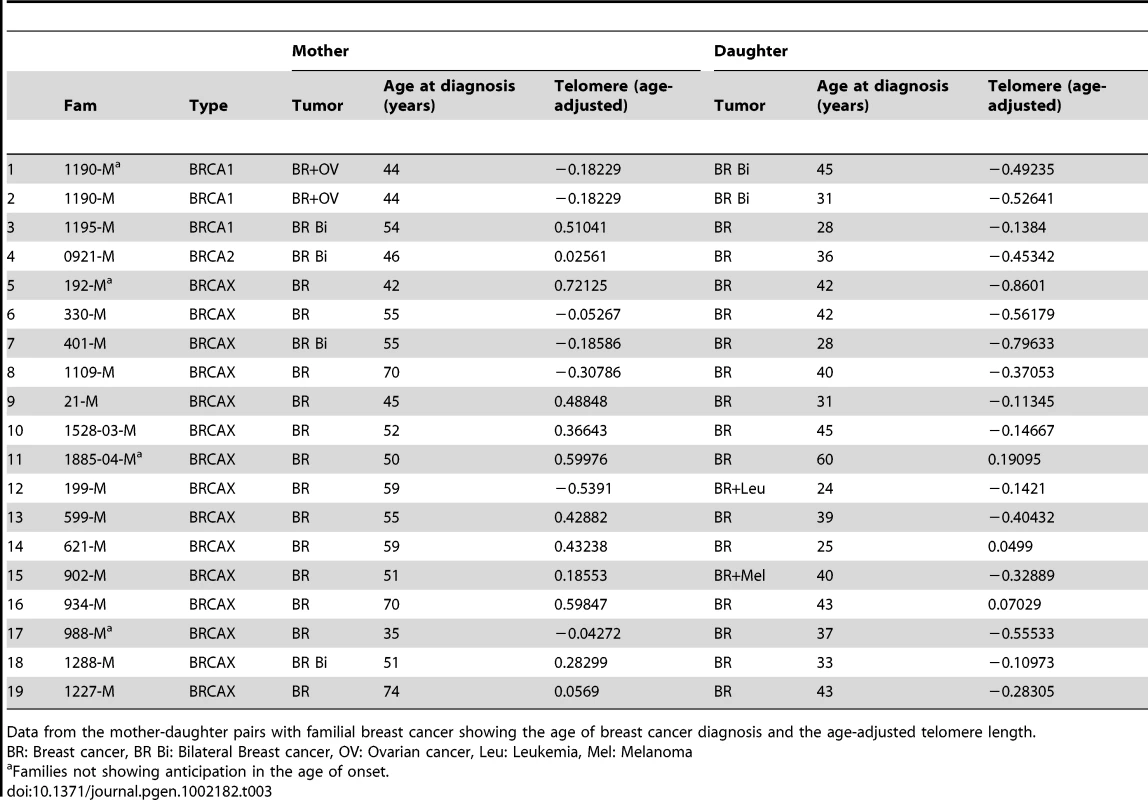
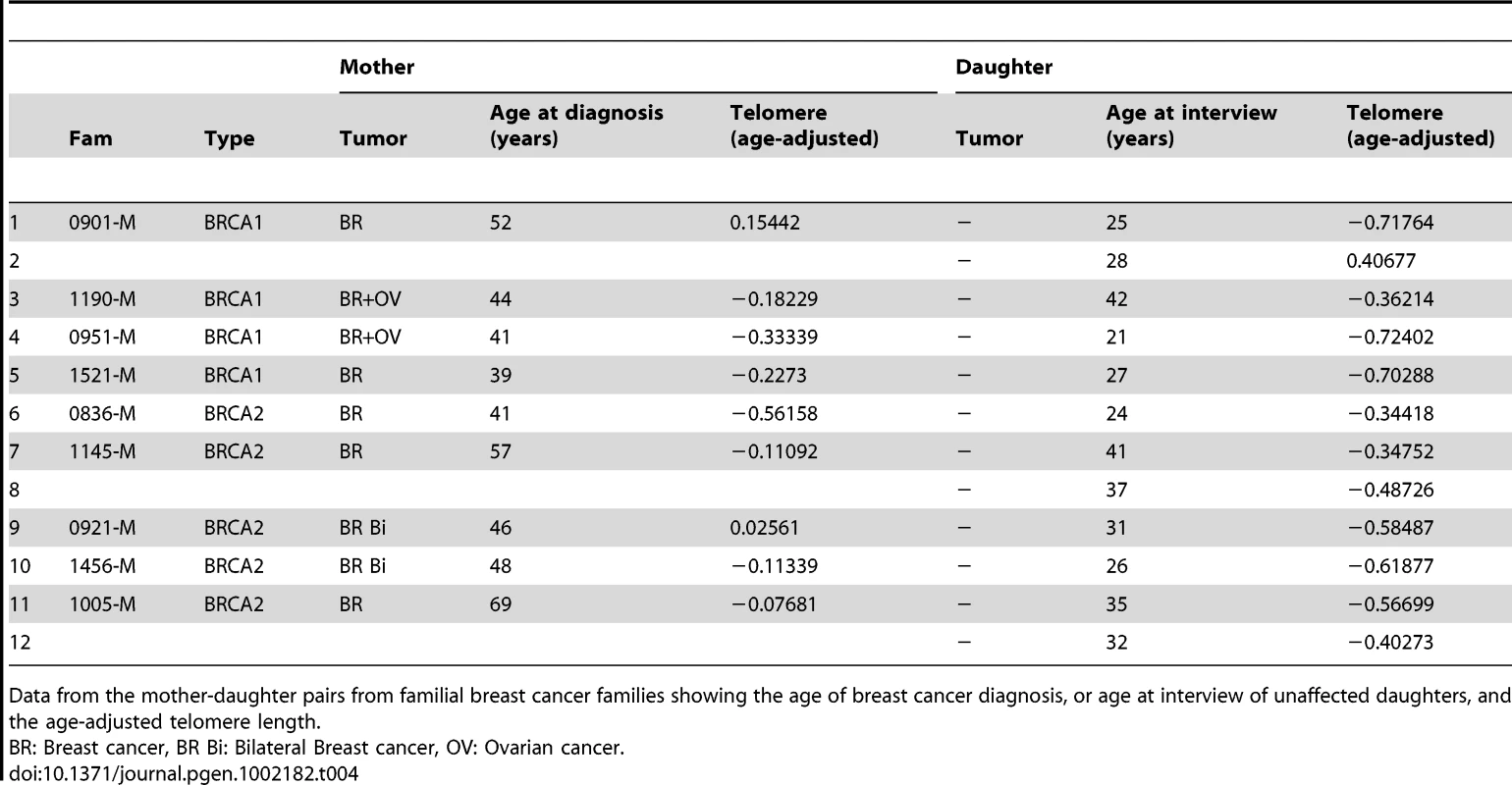
Discussion
Telomere dysfunction seems to underlie the development of a range of human genetic, degenerative, aging diseases and cancer [26]. Our results demonstrated that short telomeres in peripheral blood cells were a feature of hereditary breast cancer patients and that telomere shortening frequently occurred with successive generations in these families, suggesting that telomere shortening could be the mechanism to explain the phenomenon of age anticipation in this disease.
Decreasing age of onset in families with hereditary breast cancer has been observed before [9]–[11]. Similar to what we have found, Paterson et al. [10] reported earlier age of diagnosis, of between 6 and 9 years, in successive generations of breast cancer families. Another study performed in a smaller number of BRCA1, BRCA2 and BRCAX families demonstrated that the mean maternal age at diagnosis in the BRCA1 group was significantly lower comparing to the BRCA2 or BRCAX groups, and no significant difference was found in the mean age at diagnosis between mothers and daughters in BRCA1 families [9]. In our study we detected lower anticipation effect in BRCA1 families comparing to BRCA2 or BRCAX. Since BRCA1 mutations predispose to breast cancer at an earlier age, it would be more difficult to have large differences between generations in BRCA1 families. However, there are not definitive conclusions about whether there exists a real anticipation phenomenon. We cannot exclude that there would be alternate explanations for the earlier age of diagnosis in daughters. This observation could be due to ascertainment bias of subjects and lead-time bias, as a result of early detection of cancers by extensive screening or surveillance programs in high risk families [27], [28]. More sophisticated statistical approaches and mechanistic studies are warranted to answer this complicated problem. To date there are studies for [10], [29], [30] and against [28] a real phenomenon of anticipation in breast cancer, but a final conclusion regarding anticipation is still an open matter that is complicated by the fact that there is no molecular mechanism to explain it. Importantly we provide data indicating that telomere shortening is a possible biological explanation for the complex phenomenon of anticipation in breast cancer.
There are several studies trying to find association between short telomeres and risk of breast cancer that have reported contradictory results [16]–[19], [31], [32]. The fact that sporadic breast cancer showed normal telomere length distribution in our study agrees with previous results from case-control studies, focused on sporadic cases, indicating lack of association between telomere lengths in blood leukocytes with risk of breast cancer [31], [32]. Interestingly, one association study reported significant association with breast cancer risk in women under 50 years of age, but no association between telomere length and breast cancer in women 50 years of age or older [17]. Hereditary breast cancer, which we found characterized by short telomeres, typically occurs in women under 50 years. Then, it seems that hereditary breast cancer is associated with short telomeres, especially in BRCA1 and BRCA2 mutation carriers, as well as in a subgroup of BRCAX.
It has been reported that telomere attrition may be affected by factors such as smoking, oxidative stress or obesity [33]–[35]. Recently a prospective case-control study in breast cancer suggested that telomere shortening mainly occurs after diagnosis, as an effect of chemotherapy or other aspects of disease progression [16]. However, the observed telomere shortening in unaffected BRCA mutation carrier daughters, as well as shorter telomere length in hereditary versus sporadic cases, although they followed similar therapeutic strategies, indicate that telomere shortening is largely influenced by genetic events. Nevertheless, the results are limited by the absence of data regarding timing of the sample draw, and the application of any chemotherapy. Our results showing that telomeres of affected women from BRCA1 and BRCA2 families were significantly shorter than normal controls suggest that these genes might be involved in telomere regulation. Similarly, we can speculate that other genes involved in telomere maintenance could also be susceptibility genes that explain at least part of the BRCAX families with short telomeres.
Telomeres were shorter in affected mutation carriers versus non carriers and, moreover, we found that telomeres shortened in successive generations in affected families comparing with controls, suggesting that this is a plausible mechanism explaining the observed anticipation effect in familial breast cancer. We can speculate that mutations in BRCA1/2 or other genes induce faster telomere attrition during life time increasing the probability of genomic instability and the risk of developing breast cancer. Breast cancer would develop, first as a consequence of the inherited mutation, as this is the critical risk factor, and then the telomere length could modify the age at which the cancer would appear, as shorter telomeres at birth would reach dramatic genetic instability earlier that longer ones. On the other hand, telomere shortening could be a process mainly associated with the presence of mutations in BRCA1/2, or some other genes, regardless of the disease pathophysiology or age of presentation. Interestingly, we found four families in which daughters showed shorter telomeres than their mothers although the age of breast cancer was not anticipated with respect their mothers (Table 4), indicating that other genetic modifiers or environmental factors would be also determining the age of onset of breast cancer.
Telomere length variations as well as different telomere erosion rates were observed within the different lymphocyte subsets [36], [37]. In our study we used unselected peripheral blood leukocytes to estimate telomere lengths and then it could be affected by cell-to-cell variations. Selection of specific lymphocyte subpopulation would provide a more refined knowledge of the role that telomere length could have in cancer risk assessment.
The fact that telomere shortening has been associated with anticipation in other diseases, such as dyskeratosis congenita [13], as well as Li-Fraumeni Syndrome [7], suggest that telomere shortening may be responsible for genetic anticipation in a wide spectrum of genetic diseases.
Our findings indicate that the study of telomere length would be of relevance in the clinical surveillance and design of appropriate screening tests for patients with familial breast cancer.
Materials and Methods
Samples
Informed consent was obtained for all patients involved in this study and the research project has the approval of the ethics committee of our institution. Families used in this study were selected from the register of the Familial Cancer Consultation of the CNIO Human Genetics Group. All of them fulfilled the high risk criteria for genetic testing [38]. Index cases had been screened for mutations in BRCA1 and BRCA2 by a combination of DHPLC and direct sequencing as previously reported [39]. A total of 623 breast cancer high-risk families (40 BRCA1, 66 BRCA2, and 531 families without mutations in BRCA1/2) which included 758 mother-daughter pairs affected with breast cancer were selected to analyze the anticipation effect in the age of onset. To avoid differences in the age of onset of different types of tumors occurring in these families, i.e. breast, ovary, and other tumors, only mother-daughter pairs who developed breast tumors were used to estimate the anticipation effect.
Telomere length in familial breast cancer cases was analyzed using DNA extracted from peripheral blood leukocytes in index cases from a set of 198 Spanish breast cancer families corresponding to 48 BRCA1, 45 BRCA2, and 105 BRCAX families. In these three groups the distribution of ages at which the telomere were analyzed was for BRCA1 a mean of 43 years (range, 18–61), mean 48 years (range, 21–71) for BRCA2 cases and for BRCAX cases a mean of 48 years (range, 25–70). These samples corresponded to women with familial breast cancer who met the high risk criteria and attended the Spanish National Cancer Centre family cancer clinics between 2002 and 2009. In addition, samples from 8 affected BRCA1 mutations carriers and sisters not carrying the mutation, and 11 samples from affected BRCA2 mutations carriers and 14 healthy sisters without mutation from these families were included to study the relation between telomere length and the presence of an inherited mutation under the same genetic background.
DNA samples from 267 control women with a mean age of 46 years (range, 23 to 70 years) were also analyzed to compare normal telomere length distribution with that in breast cancer patients. Controls corresponded to Spanish healthy women without personal or familial antecedents of cancer, recruited at different Hospitals in Spain for different epidemiologic studies [40]. Age distribution of controls was homogeneous enough to demonstrate the expected decline of telomere length with age.
Seventy-one peripheral blood samples from a group of women with sporadic breast cancer at ages ranging from 31 to 61, mean 53 years, were also analyzed. These sporadic cases were consecutive newly diagnosed breast cancer patients, without familial antecedents of breast cancer, recruited between 2006 and 2007 in the different Hospitals in Madrid. These cases were included in previous studies from our group [40], [41].
Telomere-length quantification
Genomic DNA was automatically extracted from peripheral blood mononuclear cells using the MagNA Pure LC 2.0 System (Roche). Telomere length was measured using a quantitative PCR-based technique previously described [42], [43]. By this method telomere length is calculated as a ratio between telomere repeat copy number (T) and a single-copy gene, 36B4, copy number (S). Primers used to amplify telomere repeats and the 36B4 gene were described before [43]. DNA samples were amplified in a total reaction volume of 10 µl containing 1x Power SYBR Green PCR Master Mix (Applied Biosystems), 300 nM of primer Tel1, 900 nM of primer Tel2, and 30 ng of DNA. For 36B4 reactions the concentrations of primers were 300 nM of 36B4u and 500 nM of 36B4d. All samples, for both telomere and 36B4 amplifications, were analyzed in triplicate using an ABI 7900HT thermal cycler, in 384-well format. A robot Biomek NXp (Beckman Coulter) was used to load DNA and PCR mixes into the 384 PCR plates. The thermal cycling profile was the same for both assays: 95°C incubation for 10 minutes followed by 35 cycles of 95°C for 15 seconds, 54°C for 2 minutes, and 72°C for 15 seconds.
Each PCR reaction plate included two samples (DNA from the MBA-MD-436 cell line) to be used for inter-run calibration. DNA from the cell line MBA-MD-436 was used to construct a standard serial dilution series (1/4 dilutions starting from 50 ng) for PCR efficiency calculation. We observed that over 100 ng linearity is lost, and therefore samples were diluted to 10 to 30 ng for proper measurements. The amplification efficiencies (E) of each PCR were calculated from the slopes of the standard curves according to Eff = 10(−1/slope). The efficiency was calculated for each plate, both for the telomere and for the 36B4 signal. PCR data was analyzed using the SDS 2.2.2 program. The threshold value was established in the initial part of the exponential phase of the amplification curves and the crossing of this line with the curve defines the threshold cycle value (Ct) for all samples. For each sample the relative concentration of both Telomere (T) and 36B4 (S) was calculated relative to the calibration sample and PCR efficiency to obtain the T/S ratio, as previously described [14], applying the following formula:
Concordance among triplicates was checked, and the coefficient of variation was obtained for Telomere (average 0.85%, range 0.2–2.8%) and 36B4 (average 0.54%, range 0.12–1.5%). Reproducibility was tested by repeating two samples in all experiments. Good agreement between measurements were found throughout the experiments (r = 0.86).
Statistical analysis
To asses telomere length differences between control samples and hereditary and sporadic breast cancer cases, telomere length measurements were adjusted for age using the line of best fit for controls. Thus, the difference between the actual and the predicted value was calculated for each sample. Differences in age-adjusted telomere lengths were analyzed by bilateral t-tests.
The Kolmogorov-Smirnov test was used to evaluate normality in telomere length of BRCA1/2 mutation carriers and their corresponding non-carrier sisters. As a normal distribution could not be assumed, a Mann-Whitney U test was applied to evaluate distribution differences. A similar analysis was done in order to assess generational differences in telomere length between control mother-daughter pairs and mother-daughter pairs from FBOC families. Statistical calculations were performed using SPSS version 17 (SPSS Inc, Chicago, Illinois). Nominal two-sided P-values less than 0.05 were considered statistically significant.
Due to limitations of previous information regarding telomere length in the population studied, a post hoc power analysis for comparisons of telomere length among the different groups was made. Power analysis for the test between controls and sporadic cases, which showed no significant differences in telomere length, was 63%.
Zdroje
1. BrookJDMcCurrachMEHarleyHGBucklerAJChurchD 1992 Molecular basis of myotonic dystrophy: expansion of a trinucleotide (CTG) repeat at the 3′ end of a transcript encoding a protein kinase family member. Cell 69 385
2. ScholsLBauerPSchmidtTSchulteTRiessO 2004 Autosomal dominant cerebellar ataxias: clinical features, genetics, and pathogenesis. Lancet Neurol 3 291 304
3. NilbertMTimshelSBernsteinILarsenK 2009 Role for genetic anticipation in Lynch syndrome. J Clin Oncol 27 360 364
4. WestphalenAARussellAMBuserMBerthodCRHutterP 2005 Evidence for genetic anticipation in hereditary non-polyposis colorectal cancer. Hum Genet 116 461 465
5. SegelGBLichtmanMA 2004 Familial (inherited) leukemia, lymphoma, and myeloma: an overview. Blood Cells Mol Dis 32 246 261
6. BrownBWCostelloTJHwangSJStrongLC 2005 Generation or birth cohort effect on cancer risk in Li-Fraumeni syndrome. Hum Genet 118 489 498
7. TaboriUNandaSDrukerHLeesJMalkinD 2007 Younger age of cancer initiation is associated with shorter telomere length in Li-Fraumeni syndrome. Cancer Res 67 1415 1418
8. TrkovaMProchazkovaKKrutilkovaVSumerauerDSedlacekZ 2007 Telomere length in peripheral blood cells of germline TP53 mutation carriers is shorter than that of normal individuals of corresponding age. Cancer 110 694 702
9. DaganEGershoni-BaruchR 2001 Hereditary breast/ovarian cancer–pitfalls in genetic counseling. Clin Genet 60 310 313
10. PatersonADKennedyJLPetronisA 1996 Evidence for genetic anticipation in non-Mendelian diseases. Am J Hum Genet 59 264 268
11. PeixotoASalgueiroNSantosCVarzimGRochaP 2006 BRCA1 and BRCA2 germline mutational spectrum and evidence for genetic anticipation in Portuguese breast/ovarian cancer families. Fam Cancer 5 379 387
12. ArmaniosMChenJLChangYPBrodskyRAHawkinsA 2005 Haploinsufficiency of telomerase reverse transcriptase leads to anticipation in autosomal dominant dyskeratosis congenita. Proc Natl Acad Sci U S A 102 15960 15964
13. VulliamyTMarroneASzydloRWalneAMasonPJ 2004 Disease anticipation is associated with progressive telomere shortening in families with dyskeratosis congenita due to mutations in TERC. Nat Genet 36 447 449
14. WilleitPWilleitJMayrAWegerSOberhollenzerF 2010 Telomere length and risk of incident cancer and cancer mortality. JAMA 304 69 75
15. WuXAmosCIZhuYZhaoHGrossmanBH 2003 Telomere dysfunction: a potential cancer predisposition factor. J Natl Cancer Inst 95 1211 1218
16. PooleyKASandhuMSTyrerJShahMDriverKE 2010 Telomere length in prospective and retrospective cancer case-control studies. Cancer Res 70 3170 3176
17. ShenJGammonMDTerryMBWangQBradshawP 2009 Telomere length, oxidative damage, antioxidants and breast cancer risk. Int J Cancer 124 1637 1643
18. ShenJTerryMBGurvichILiaoYSenieRT 2007 Short telomere length and breast cancer risk: a study in sister sets. Cancer Res 67 5538 5544
19. SvensonUNordfjallKStegmayrBManjerJNilssonP 2008 Breast cancer survival is associated with telomere length in peripheral blood cells. Cancer Res 68 3618 3623
20. HedenfalkIRingnerMBen-DorAYakhiniZChenY 2003 Molecular classification of familial non-BRCA1/BRCA2 breast cancer. Proc Natl Acad Sci U S A 100 2532 2537
21. BlascoMA 2005 Telomeres and human disease: ageing, cancer and beyond. Nat Rev Genet 6 611 622
22. BallalRDSahaTFanSHaddadBRRosenEM 2009 BRCA1 localization to the telomere and its loss from the telomere in response to DNA damage. J Biol Chem 284 36083 36098
23. CabuyENewtonCSlijepcevicP 2008 BRCA1 knock-down causes telomere dysfunction in mammary epithelial cells. Cytogenet Genome Res 122 336 342
24. McPhersonJPHandeMPPoonepalliALemmersBZablockiE 2006 A role for Brca1 in chromosome end maintenance. Hum Mol Genet 15 831 838
25. BadieSEscandellJMBouwmanPCarlosARThanasoulaM 2010 BRCA2 acts as a RAD51 loader to facilitate telomere replication and capping. Nat Struct Mol Biol 17 1461 1469
26. CaladoRTYoungNS 2009 Telomere diseases. N Engl J Med 361 2353 2365
27. KingMCMarksJHMandellJB 2003 Breast and ovarian cancer risks due to inherited mutations in BRCA1 and BRCA2. Science 302 643 646
28. PatersonADNaimarkDMHuangJVachonCPetronisA 1999 Genetic anticipation and breast cancer: a prospective follow-up study. Breast Cancer Res Treat 55 21 28
29. HohJHeitjanDFMeretteCOttJ 2001 Ascertainment and anticipation in family studies. Hum Hered 51 23 26
30. VehmanenPFriedmanLSEerolaHSarantausLPyrhonenS 1997 A low proportion of BRCA2 mutations in Finnish breast cancer families. Am J Hum Genet 60 1050 1058
31. De VivoIPrescottJWongJYKraftPHankinsonSE 2009 A prospective study of relative telomere length and postmenopausal breast cancer risk. Cancer Epidemiol Biomarkers Prev 18 1152 1156
32. ZhengYLAmbrosoneCByrneCDavisWNeslineM 2010 Telomere length in blood cells and breast cancer risk: investigations in two case-control studies. Breast Cancer Res Treat 120 769 775
33. EpelESBlackburnEHLinJDhabharFSAdlerNE 2004 Accelerated telomere shortening in response to life stress. Proc Natl Acad Sci U S A 101 17312 17315
34. ValdesAMAndrewTGardnerJPKimuraMOelsnerE 2005 Obesity, cigarette smoking, and telomere length in women. Lancet 366 662 664
35. von ZglinickiT 2002 Oxidative stress shortens telomeres. Trends Biochem Sci 27 339 344
36. AvivAValdesAMSpectorTD 2006 Human telomere biology: pitfalls of moving from the laboratory to epidemiology. Int J Epidemiol 35 1424 1429
37. Van ZiffleJABaerlocherGMLansdorpPM 2003 Telomere length in subpopulations of human hematopoietic cells. Stem Cells 21 654 660
38. MilneRLOsorioACajalTRVegaALlortG 2008 The average cumulative risks of breast and ovarian cancer for carriers of mutations in BRCA1 and BRCA2 attending genetic counseling units in Spain. Clin Cancer Res 14 2861 2869
39. DiezOOsorioADuranMMartinez-FerrandisJIde la HoyaM 2003 Analysis of BRCA1 and BRCA2 genes in Spanish breast/ovarian cancer patients: a high proportion of mutations unique to Spain and evidence of founder effects. Hum Mutat 22 301 312
40. MilneRLRibasGGonzalez-NeiraAFagerholmRSalasA 2006 ERCC4 associated with breast cancer risk: a two-stage case-control study using high-throughput genotyping. Cancer Res 66 9420 9427
41. EastonDFPooleyKADunningAMPharoahPDThompsonD 2007 Genome-wide association study identifies novel breast cancer susceptibility loci. Nature 447 1087 1093
42. CawthonRM 2002 Telomere measurement by quantitative PCR. Nucleic Acids Res 30 e47
43. CoddVManginoMvan der HarstPBraundPSKaiserM 2010 Common variants near TERC are associated with mean telomere length. Nat Genet 42 197 199
Štítky
Genetika Reprodukční medicínaČlánek vyšel v časopise
PLOS Genetics
2011 Číslo 7
Nejčtenější v tomto čísle
- Genome-Wide Association Study Identifies Novel Restless Legs Syndrome Susceptibility Loci on 2p14 and 16q12.1
- Loss of the BMP Antagonist, SMOC-1, Causes Ophthalmo-Acromelic (Waardenburg Anophthalmia) Syndrome in Humans and Mice
- Gene-Based Tests of Association
- Genome-Wide Association Study Identifies as a Susceptibility Gene for Pediatric Asthma in Asian Populations
